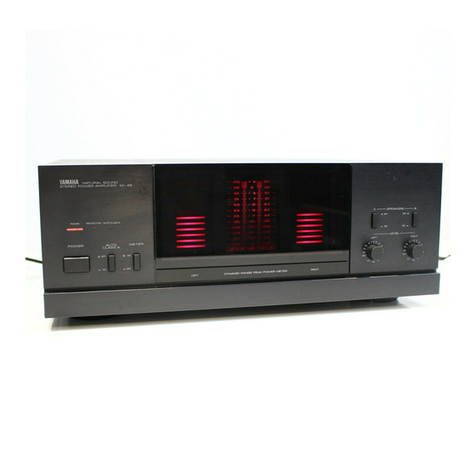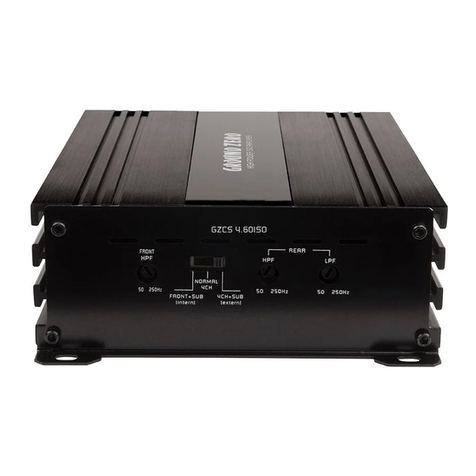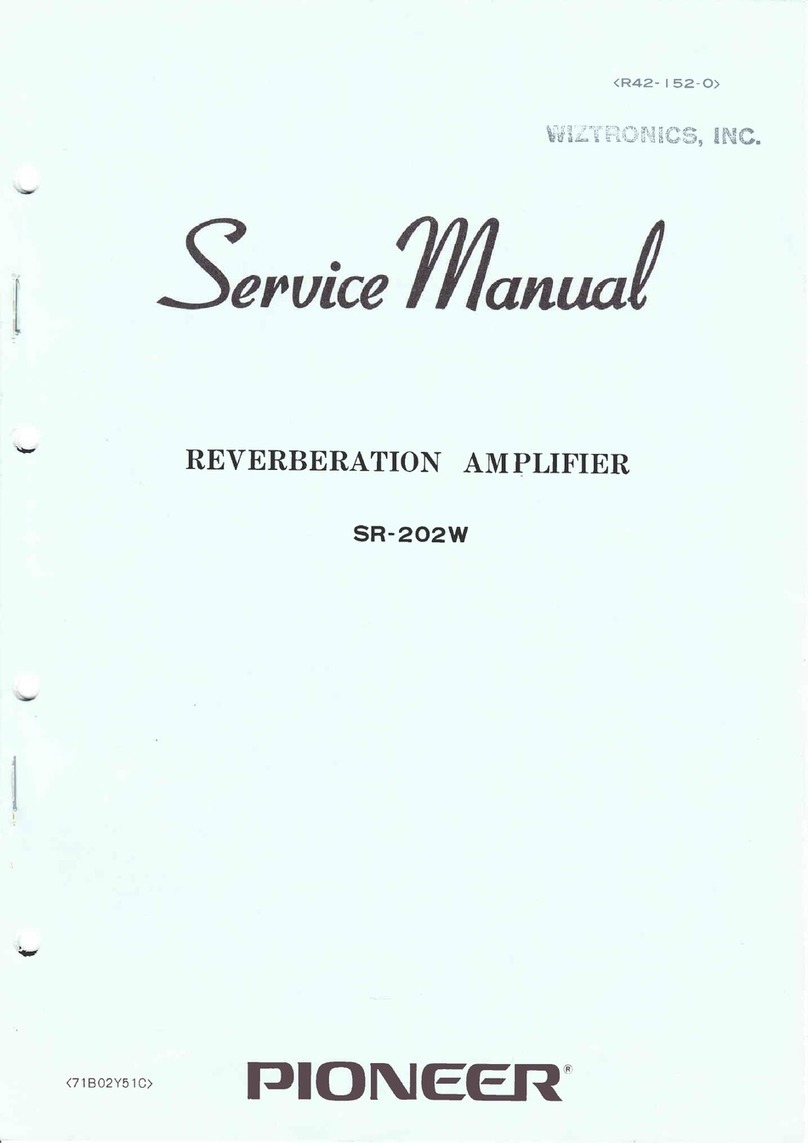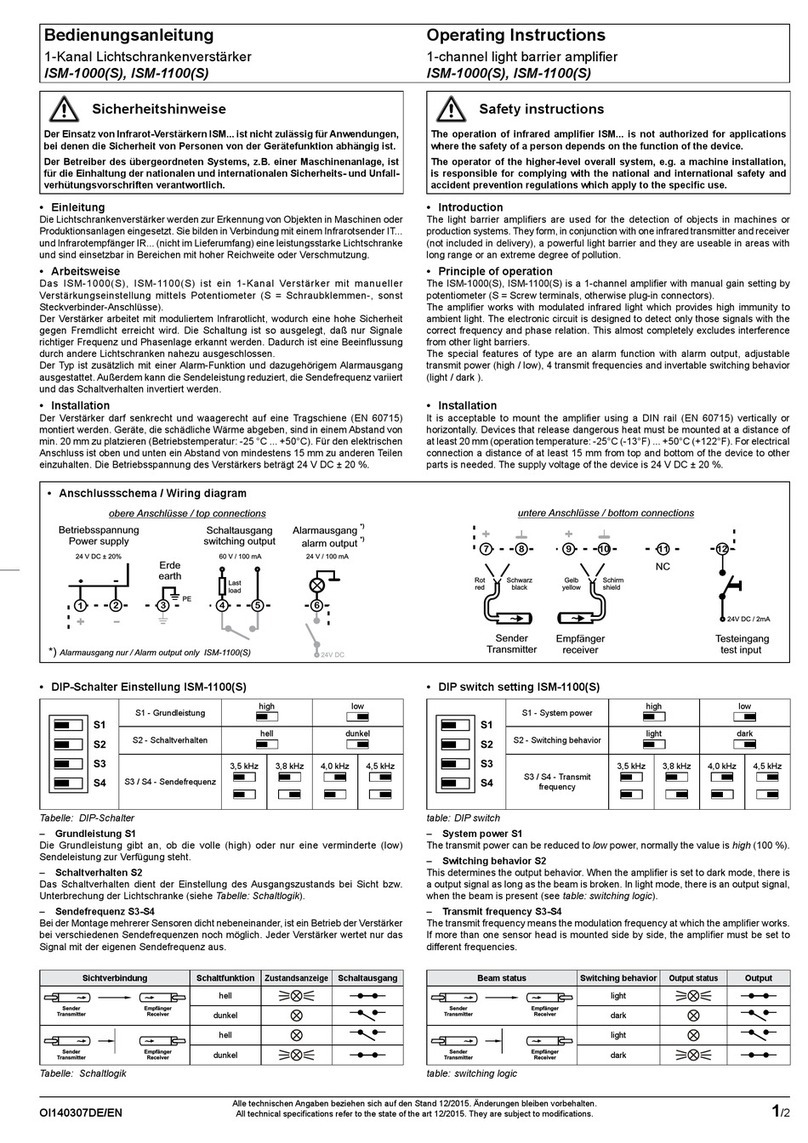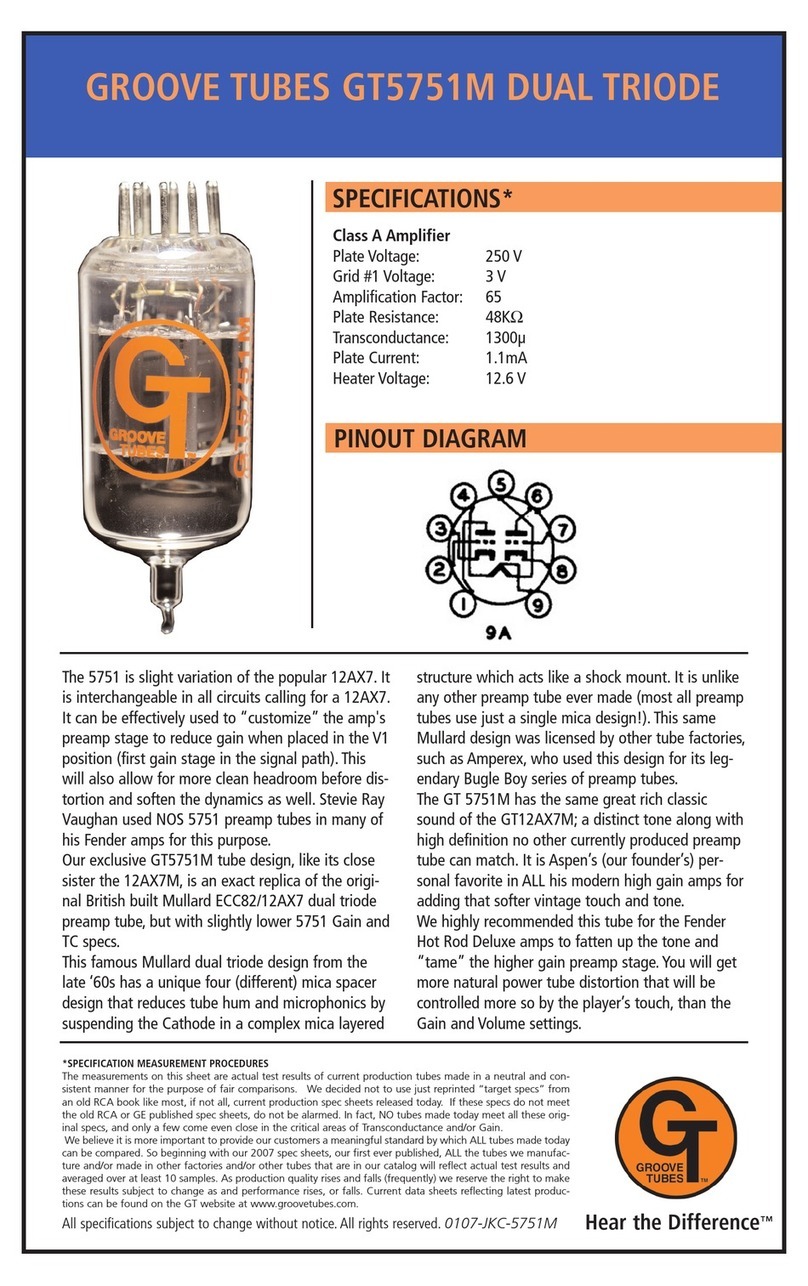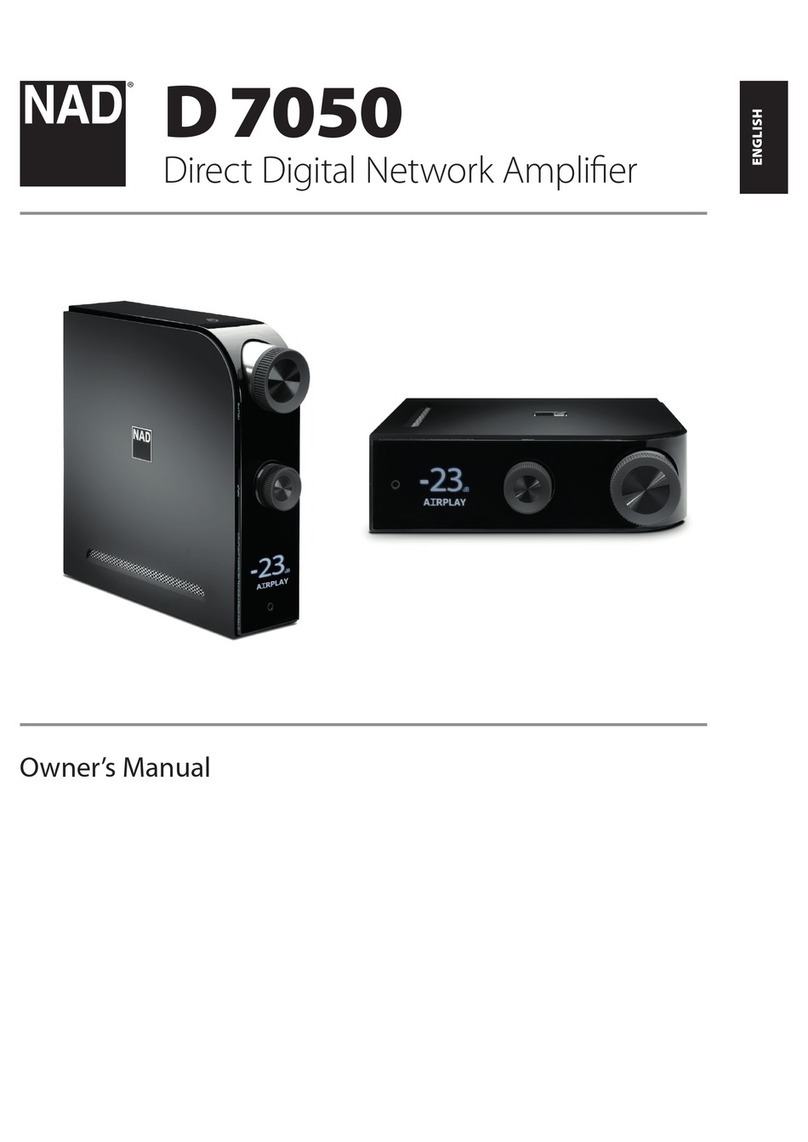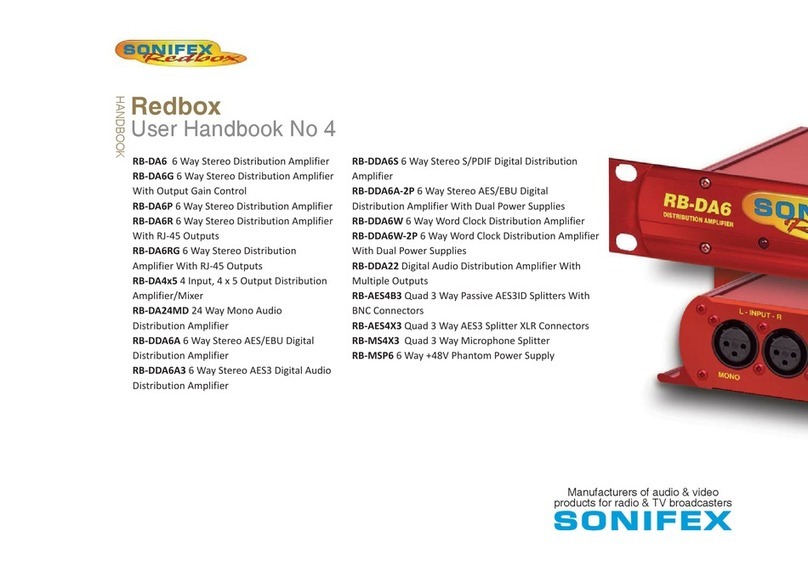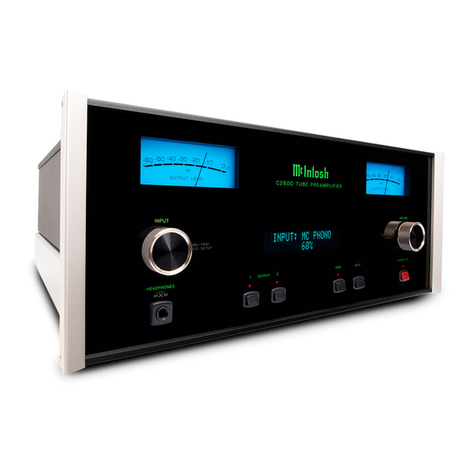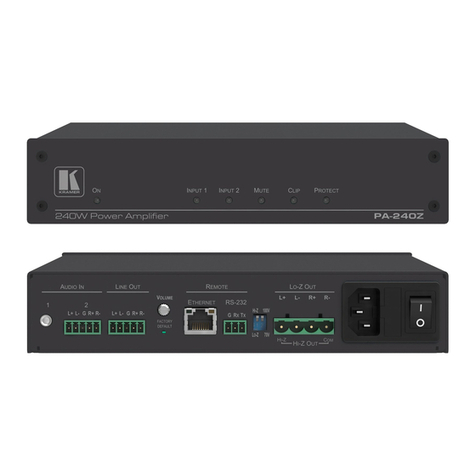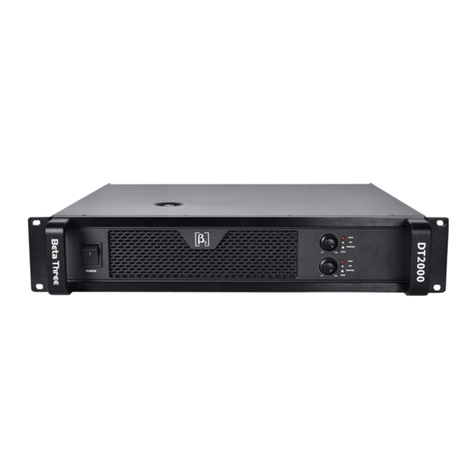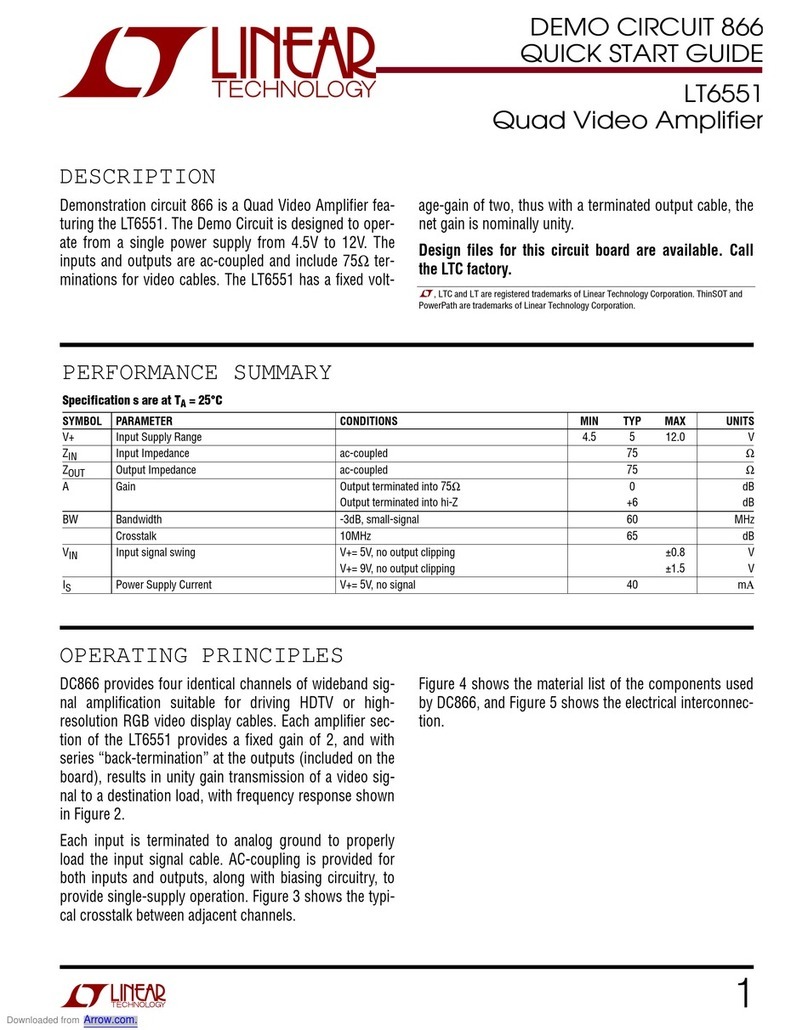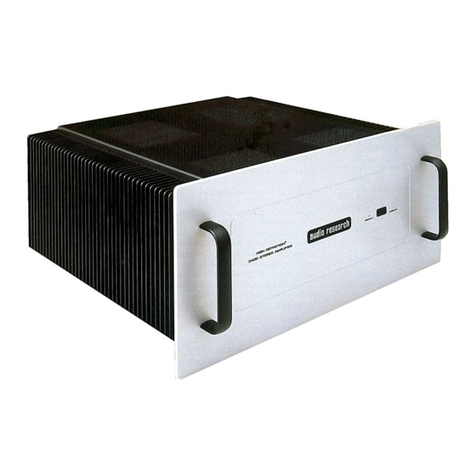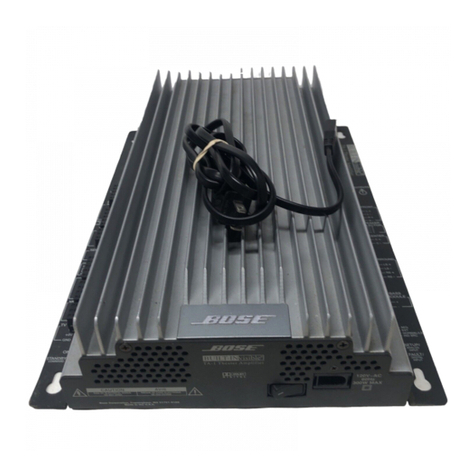Glasshouse 300BSE Series User manual

page 1
Glasshouse
300BPSE 01/05/04
b. specifications
c. requirements of constructor
CHAPTER 1 - INTRODUCTION
a. about the Glasshouse 300BSE series amplifier
The Glasshouse 300BSE series kit amplifier, features the classic 300B valve in single ended configuration. It is
available in two versions, the 300BSEi integrated (with 6 line-level sources and one tape out) and the power amplifier
version, 300BSEp (driven by a pre-amplifier, passive or active) The output power is 12 watts into a 6ohm load, so
speakers of 89dB and above are required.
The main HT rail is valve rectified using the 5U4 valve, smoothed by a 10H choke and a combination of 4 reservoir
capacitors in a Pi network. This powers the 300B and the EF86 input valves. The driver valve, the 5687 has its own
dual supply +195Vdc and -195Vdc, formed by a solid state supply. All valve heater supplies are regulated DC. The
amplifier is feedbackless and hardwired, with huge 120 lam 2.5 inch stack output transformers, sitting at the rear,
astride the mains transformer. She is housed in a beautifully designed 2.5mm aluminium chassis, crowned with a
copper plate, with a black transformer cover and valve cover (optional).
power output
input sensitivity
hum/noise
bandwidth +/- 1db
input impedance
AC mains voltage input
power consumption
dimensions
weight
connectors
valve sockets
valve compliment
12 watts into an 8 ohm load
370mV
1.2mV
16Hz - 20kHz
100Kohm
110V/120V/220V/230V +/-10%
220W
440mm(w) x 230mm(h) x 440mm(d)
25kg
IEC lead, RCAs x 7pairs(BSEi) or x 1pair(BSEp), 4mm spk post x 2pair
4 x 9BA, 1 x octal, 2 x UX4
2 x EF86, 2 x 5687, 1 x 5U4, 1 x 300B
1.The kit builder needs to be able to solder to a good standard, the majority of problems that occur with kits are down
to poor soldering.
2. Be able to read and understand these instructions completely.
3. To have some knowledge of valve circuitry, general electronics and be able to read a circuit diagram.
4. To have a multimeter that can read up to 1000V dc and be able to use the meter properly.
5. Have access to a dummy load, or a spare pair of speakers and be able to connect them to the amplifier during
testing.
6. Be aware of the precautions necessary to avoid electric shocks from the mains and amplifier power lines.
7. Have patience, if you rush, you will make mistakes.
d. warantee
Part built kits cannot be returned for a full refund. Defective parts will be replaced, provided they are returned within 60
days of purchase and are confirmed to be defective and not misused. Please note that Hi-fi Collective Ltd will assist in
anyway to get your kit up and running. To help you with your inquires, our phones are manned Monday - Friday,
9.00am - 5.00pm, we try to answer e-mails within an hour of them being read. We offer a repair service and will even
finish off a part built amplifier for you. Also, we have a "Turn-on" service, where we will check your work, switch her on,
test her and play her for 20hrs+. We charge £18.00 an hour for labour.
e. disclaimer
WARNING: The high voltages present in this kit can KILL and the high operating voltages can BURN. Observe all
precautions and never connect the kit to an electrical supply until it has been fully assembled, checked and checked
again and ready for testing. You should comply to the requirements of the constructor as listed in c. above. In the
action of purchasing this kit you assume total responsibility and liability for the use and operation of this kit both for
yourself and people around you.
f. company details
address: Hi-fi Collective Ltd, 21 Lakes Lane, Newport Pagnell, Bucks, MK16 8HS
tel/fax: 00 44 (0) 1908 217202

page 2
Glasshouse
300BPSE 01/05/04
Before soldering, make sure the wire and/or component lead is bent around the tag or valve pin that you are planning
to solder. Place the tip of the soldering iron onto the surface of all parts, hold for 1.5 seconds. Apply the solder to the
junction, do not flood the join with solder. The whole process should take about 3 seconds.
a. work place
Whether in a dedicated workshop, the garage or on the dining room table, an organised work place will save you time
and prevent mistakes.
Have your tools close to you & in one place and when you have finished using them put them back. Keep your
instructions to hand and try not to rip pages out. It is a good idea to protect you table, an offcut of carpet will work well.
You need to have easy access to your soldering iron and solder, always turn it off when not using it especially those of
you who have young children. Your work space needs to be well lit with good ventilation to move solder fumes away
from you. Above all keep it clean, you don`t want to scratch your chassis on a forgotten nut.
b. soldering iron and solder
Your solder and iron are the most important tools in an electronic constructors tool box, but some people get the
combination wrong. A good solder join is one that is shinny, with an even amount of solder on the joint & without brown
flux residue. To get it right, first you must have an iron that gets hot enough to melt your solder properly. Most hobbiest
soldering irons have a tip temperature of around 370 degree C, for example the 25W Antex iron goes to around 390
degree C. Such irons will work well with solder that change from solid to liquid at around 200 degree C. A higher iron
temperature will give good flow to higher temperature solders, these change at 300 degree C. Working with these types
with your normal 25W Antex will cause dry joints. See section e of the chapter to see which solder and iron to buy.
d. preparing the wire
The wire provided to assemble the 300BSE series has to be prepared before soldering, you need to expose 10mm of
wire as a rule. Wire 1/0.6 is PTFE sleeved, silver plated copper wire. When preparing an end, use your snipe nose
pliers and lightly squeeze the end. The PTFE sleeving will split and you can peel it like a banana to expose the wire.
Cut off the excess sleeving and you are ready to solder.
The remaining wires provided can be stripped using your wire strippers. With multistrand wire it is a good idea to twist
the ends & tin with solder before working them, this also applies to all the transformer wires.
c. soldering technique
CHAPTER 3 - PREPARATION
Carefully open the boxes and remove the items. You will see your receipt for the kit in the large box, make sure the
items listed are correct. Also, enclosed are the parts list booklet, instructions booklet and kit pictures booklet. Remove
all packing carefully and lay items out ready for cross checking.
With the parts list in front of you tick off the non bagged items. Then all the bagged items, 9 bags in total. To help you
identify the numerous parts we have included a parts identifier page at the back of the parts list. On each bag you will
see a label, describing its contents.
Any shortfall please contact Hi-fi Collective once a complete count is done.
CHAPTER 2 - UNPACKING and PARTS LIST
a. taking delivery
Your Glasshouse 300BSE series amplifier will arrive with you via United Parcel Service couriers (UPS), they can
deliver any time of the day, so it is a good idea to have somebody around to receive collection, contact Hi-fi Collective
Ltd for the delivery day. If they attempt to deliver and you are not in, then they will leave a contact card with a number
for you to call, to arrange a suitable day. When delivered you will have to sign for it. Have a quick look at the box
exterior for any sign of damaged, in the unlikely event of this happening get the driver to write a note describing the
damage and get him to sign it. Contact Hi-fi Collective with the details.
The kit will arrive to you in two boxes. Box No. 1, will contain the mains transformer and 2 off output transformers (box
dimensions 400mm x 250mm x 200mm, weight 17kg). Box No. 2, will contains the chassis parts, valves (if ordered),
choke, hardware and components (box dimensions 550mm x 600mm x 350mm(h) weight 12kg).
b. unpacking

pick list
tools
pick list
tools
page 3
Glasshouse
300BPSE 01/05/04
page 3, picture booklet
CHAPTER 4 - FITTING OF HARDWARE (refer to hardware identifier list)
Speaker posts x 4
1. Phillips screw driver
2. 10mm spanner
a. fitting of speaker posts
Follow the pictures on page 2 of the picture booklet for the fitting of each speaker post,
start with post No. 1 first. Tighten the post in postion by hand. Unscrew the speaker head
to access the side hole of the speaker post`s body, insert a screw driver throught this hole.
Tighten the head screw onto the screw driver by hand.
The aim is to achieve a 45 degree angle of entry into the side hole. When using the 10mm
spanner, you will see that you have limited movement of the spanner, inside the amp. By
using a combination of rotating the screw driver and adjustment of the position of both the
screw driver and the spanner you will be able to tightening the post in place. Follow the
same procedure to fit post No. 2, then No. 3 and finally No. 4.
page 2, picture booklet
d. tool list
Multimeter (318)
Economy tool kit
(side cutters, snipe nose pliers, wire
strippers, flat blade & phillips
screwdriver, tool case)
Allen key set (PSEi only)
8mm spanner
10mm spanner
12mm spanner
electrical tape (black)
16 piece 1/4 inch socket set
2 x 6R dummy load
Antex 25 W soldering iron
Solder 2% silver
Audio Note silver solder
Electrical safety gloves
M3 nut drivers
M4 nut drivers
TOOL01 - £26.43
TOOL02 - £11.29
TOOL03 - £2.29
TOOL04 - £1.79
TOOL05 - £2.00
TOOL06 - £2.36
TOOL07 - £0.79
TOOL08 - £35.00
TOOL09 - £4.32 -2 x (6 x 1R 5watt resistor to be wired in series per load)
TOOL10 - £15.65
TOOL11 - £33.36 (250g reel, plenty to make several amps)
AN.SOLDER - £9.00 (30g 3 off required to make amp)
TOOL12 - £20.00 (1000Vdc working)
TOOL13 - £3.90
TOOL14 - £4.50
b. fitting of phono sockets
Fit a red RCA (phono) sockets as shown on page 3 of the picture booklet, into the "R" right
channel "record" location. Tighten by hand, align the solder tag so it is pointing up to the
chassis lip (base). Use a 12mm socket set internally to hold the phono in place and tighten
with the 12mm spanner externally, this way the solder tag will stay in place. To ease
tightening of the RCAs, place the chassis rear slightly over the table edge. Now, fit "input
6", then "input 5"... Once the line is completed, fit the "L" channel RCA black sockets, again
start with the "record" location.
If you are building the 300BSEp you need only fit one pair, fit these at the "input 1" position.
Fit the "R" channel RCA first then the "L" left. Blank off the remaining RCA socket holes
with the RCA insulation hole plugs provided. These snap into place easily.
300BPSEi:
Red RCA sockets x 7
Black RCA sockets x 7
300BSEp:
Red RCA sockets x 1
Black RCA sockets x 1
RCA insulation hole plugs x
12
1. 12mm socket set with
extension
2. 12mm spanner
All items listed above constitute a list of tools required to construct one of our 300BSE kits. They are available from
www.hificollective.co.uk prices shown exclude vat. You can order on-line or by fax / telephone to 01908 217202.

pick list
tools
pick list
tools
pick list
tools
pick list
tools
page 4
Glasshouse
300BPSE 01/05/04
page 4, picture booklet
d. fitting of IEC socket with fuse holder
Position the IEC socket & fuse holder the correct way round onto the chassis, see page 4 of
the picture booklet, and fit in place with the screws and nuts provided. Remove the fuse
tray, this can be levered out by careful use of a flat head screw driver. Snap in the fuse
onto the tray into the correct compartment and re-insert into the socket. For 220V/230V
operation you need a 1A anti-surge fuse, for 100V/110V/120V operation you need a 2A anti
-
surge fuse. Always use the correct fuse.
e. fitting of the silver anodised front panel
c. fitting of earth post
The earth post is located at the rear panel marked "earthpost". Fit as shown on page 4 of
the picture booklet. Make sure you scratch off the paint with a small flat head screw driver
where the serated washer contacts with the chassis internally, this ensures a good chassis
earth connection for safety purposes. Splay out the solder tags so they are not lying on top
of each other as you will need to solder wires to these later. Tighten by hand, then use a
8mm socket set or nut driver, internally to hold in place and tighten with an 8mm spanner
externally. You will need to unscrew the earth post`s head to fit.
earth post x 1
M4 solder tags x 2
1. 8mm socket set with
extension or 8mm nut driver
2. 8mm spanner
3. small flat head screw
driver
IEC socket with fuse holder
x 1
fuse x 1
M3 x 16 silver pozi-drive
screws x 2
M3 nut x 2
page 4, picture booklet 1. Phillips screw driver
2. M3 nut driver
3. small flat head screw
driver
Fit the front panel the correct way round. It is held in place by 4 screws that pass through
holes in the main chassis front panel and screw into threaded inserts on the silver anodised
front panel. To assist you can hold the screw in place on top of your phillips screw driver
with a wrap of electrical tape.
silver anodised front panel x
1
M4 x 6 black pozi-drive
screws x 4
page 6, picture booklet 1. Phillips screw driver
2. Electrical tape
f. fitting of valve base, V7
See page 8 of the picture booklet for orientation of the valve base, note the position of the
locator key in the centre of the valve base. The ring slips onto the valve base, pushing the
base onto the inside of the top of the chassis. Use the countersunk screws and fit the nuts,
tighten by hand. For the final tightening, use the pliers to hold the nut and do the work with
the screw driver. It is well worth tightening one screw a little then working on the other, then
back to the first. This ensures that the valve base lies flat.
octal valve base x 1
valve base fixing ring x 1
M3 x 10 silver pozi-drive
countersunk screws x 2
M3 nut x 2
page 8, picture booklet 1. Phillips screw driver
2. snipe nose pliers

pick list
pick list
tools
pick list
tools
pick list
tools
page 5
Glasshouse
300BPSE 01/05/04
g. fitting of copper plate
You will see that one side of the copper plate has a horizontal grain, this is the top, visible
side. Place on top of the main chassis, you will see that it is slightly smaller than the
chassis, but the holes will line up. Once aligned you can start fitting the top surface
hardware. Pls note that copper is a soft metal and will distort slightly, so do not over tighten
any of the screws. Also, even though the lacquer is baked on, it will scratch easily.
copper plate x 1
page 6, picture booklet
h. fitting of standoffs, valve bases and grommets
Follow closely the pictures on page 6 & 8, for the correct location of the different sized
standoffs and correct orientation of the valve bases.
For the STANDOFFS, use the phillips screw driver to hold the screw and tighten with the
M3 nut runner holding the standoff. You will find 8 locations to the rear of the chassis
where the hole cutout of the copper plate is larger that that of the main chassis. Here, you
must use the M3 x 10 silver countersunk screws with the M3 x 20mm standoffs. (NB only 4
required for 300BSEp). For all the remaining standoff locations use the M3 x 12 black
screws.
For the valve bases V1/V2/V3/V4 use the M3 x 12 black screw with the M3 nuts, follow the
same procedure as described in ( f ) for correct fitting.
V5/V6 fit directly onto the M3 x 15mm standoffs, using M3 x 12 black screws. Note the
orientation of the valve bases, 2 pin holes are larger than the other 2, refer to the pictures.
The 6 grommets are fitted to the rear of the top surface to protect wires going into the main
chassis. They fit snugly into position.
B9A valve base x 4
B9A base fixing ring x 4
UX4 valve base x 2
M3 x 20mm standoffs x 14
(10 for 300BSEp)
M3 x 25mm standoffs x 2
M3 x 15mm standoffs x 4
M3 x 10 silver countersunk
screws x 8
(only 4 required for
300BSEp)
M3 x 12 black pozi-drive
screws x 40
large PVC grommets x 4
small PVC grommets x 2
page 6 & 8, picture
booklet
1. Phillips screw driver
2. M3 nut driver
3. snipe nose pliers
i. fitting of LM323K 5V voltage regulators
These devices are used to provide a regulated dc supply for the heaters of V1-V6. 4 are
used, one providing the heater supply for V1/V3, one for V2/V4 (incorporating diodes in the
circuit to achieve 6.3Vdc), one for V5 and the last for V6. They are bolted onto the chassis
which acts as a heatsink. The body of the device is the common connection, so they are
isolated from the chassis by using mounting kits.
Refer to page 5 of the picture booklet. Make sure the solder tags point to the front of the
amp, ready for soldering later.
LM323K x 4
M3 x 16 silver pozi-drive
screws x 8
M3 nut x 8
M3 solder tag x 4
mounting kit x 4 (insulation
washers x 2, rubber pad x 1,
per device)
page 5, picture booklet 1. Phillips screw driver
2. M3 nut driver
j. fitting of choke, capacitor clip and capacitor C5
Align the choke over its 4 fitting holes, with the solder pins facing V7. Fit in place using the
M4 x 10 black screws and M4 nuts provided. For the final fixing use pliers to hold the nut in
place and tighten with the phillips screw driver.
Fit the capacitor clip, using a M4 x 10 black screw and a M4 nut. Tighten using the M4 nut
driver with the phillips screw driver holding the screw in place. Using 1 off M3 x 12 black
screw and a M3 nut, join the 2 arms of the clip together. Only turn the nut a couple of
times, now you can slide in capacitor C5. One in place tighten the arms together with the
pliers holding the nut and tightening with the phillips screw driver. Orienation of the
capacitor is vital.
choke x 1
capacitor clip x 1
capacitor C5 x 1(bag 2)
M4 x 10 black pozi-drive
screw x 5
M4 nut x 5
M3 x 12 black pozidrive
screw x 1
M3 nut x 1
page 1, picture booklet 1. Phillips screw driver
2. pliers
3. M4 nut driver

pick list
tools
pick list
page 5, picture booklet
pick list
p1 & 15 & 16, pic booklet
page 6
Glasshouse
300BPSE 01/05/04
Cut 8 lengths of 15cm 24/0.2 red wire and 8 lengths of 2cm heat shrink. Look closely at
page 5 of the picture booklet, you will see that you must solder wires onto the pin outs of
the LM323Ks and cover the join with heat shrink. It is best to use a hair dryer on "hot"
setting to shrink the heat shrink.
Once done, label the ends of each of the wires so that you can identify the U number and
whether it is Vout or Vin once the wires are passed through the small grommet. These are
wired in later. Writing on masking tape works well as a label
b. fitting of tag boards & selector PCB (300BSEp only)
Pay close attention to page 15 & 16 of the picture booklet to see which holes in the centre
part of the tag boards are used for fixing and which way round the selector PCB goes.
When fitting boards PSU3 & PSU4, make sure the red flying leads are coming out between
U1/U2 & U3/U4, respectively, for easy access later.
24/0.2 red x 1.2m
heat shrink x 16cm
masking tape for identifying
leads
tag boards x 6
M3 x 12 Black pozi-drive
screws x 12
CHAPTER 5 - WIRING THE AMPLIFIER
a. fitting of flying leads to U1/U2/U3/U4
page 7, picture booklet 1. Extra pair of hands
2. Phillips screw driver
3. M4 nut driver
k. fitting of mains and output transformers
Before starting, I must state that this stage involves HEAVY lifting. Each transformer
weighs in at 5kg, the combined weight of the chassis and transformers is 23kg. You must
ask for help, this is a 2 man lifting exercise.
Fit in this sequence - output (either position), mains(middle), output. Note the orientation of
the transformers, looking at the postion and colour of the leadouts will help. This is vital for
low hum operation. The pictures will detail which wires are to go through which holes.
Align the first transformer over its fixing holes, insert its 4 x M4 x 10 black screws. Angle
that corner on the amp over the table lip, with your "extra pair of hands", keep the amp
stable, you can gain access underneath to hand fit the M4 nuts. Final fit with a M4 nut
driver tightening, while the phillips holds the screw steady. Insert the wires of this
transformer through the correct grommeted hole. Fit the remaining transformers following
the same method.
Make sure you do not sandwich any of the leads between the chassis and the transformer,
this is very DANGEROUS .
Push the transformer leadouts through the correct grommet as suggested.
mains transformer x 1
output transformer x 2
M4 x 10 screw x 12
M4 nut x 12

pick list
pick list
pick list
pick list
page 7
Glasshouse
300BPSE 01/05/04
page 8 & 12, picture booklet
page 8 & 13, picture booklet
f. wiring of PSU3 tag board
This board provides the heater voltage to V2/V4 - 6.3Vdc and V6 - 5Vdc. Follow page 8 &
page 12.
You will see that all the wiring information is provided in these pictures, which wire to use
and where the wires are connected to.
Twist together the 2 pink wires from the mains transformer and follow the same practice for
the orange wires from the mains transformer.
When wiring the "common" connection of U1 & U2 you are connecting to the solder tag on
the body of the LM323K.
Wire runs to the heaters are twisited together slightly to keep them close together.
Try to avoid any physical contact of wires to the body of any of the LM323Ks are they do
run warm.
orange 1/0.6
red 24/0.2
green/yellow 24/0.2
page 1,4, 8, 15 & 16, picture booklet
e. wiring of PSU4 tag board
This board provides the heater voltage to V1/V3 - 6.3Vdc and V5 - 5Vdc. Follow page 8 &
page 13.
You will see that all the wiring information is provided in these pictures, which wire to use
and where the wires are connected to.
Twist together the 2 green wires from the mains transformer and follow the same practice
for the yellow wires from the mains transformer.
When wiring the "common" connection of U3 & U4 you are connecting to the solder tag on
the body of the LM323K.
Wire runs to the heaters are twisited together slightly to keep them close together.
Try to avoid any physical contact of wires to the body of any of the LM323Ks are they do
run warm.
orange 1/0.6
red 24/0.2
green/yellow 24/0.2
page 1, 9, 10, 11, 12, 13, 15 & 16, pic booklet
d. fitting of R45, valve base & C5 components
Follow page 1, 8, 15 & 16 for the fitting of all valve base located components, try and keep
lead lengths to a minimum.
For the fitting of R45 see page 4.
R1 is connected between V7, pin 8 and pin 1 of the choke. This resistor sees a very high
voltage so ensure there is no contact with the chassis, vavle base ring or body of the
choke. See page 1 & 8.
For R6 & R7 fitting see page 1.
R17-20
R31-34
R1
R39-R42
R6
R7
R45
c. fitting of components to tag boards
Each tag board has 36 tags these are labelled and referenced throughtout the wiring phase.
Bags 1 - 6 of the kit contain the components, each is labelled, identifying the contents
clearly. Some components need to be correctly orientated, see page 9, this is very
important as they can blow up. Some components are positioned on the underside of the
tag boards. Keep to the specified layout it has been proven to give minimal hum and in
certain case it is the only way some components will physically fit.
The higher wattage resistors 1W and above need to be spaced 10mm off the tag board as
they do get hot and in time can tarnish the tag board. Otherwise keep lead lengths to a
minimum.
Make absolutely sure no leads are touching the chassis, tag board fixing screws or
underlying standoffs.
Once they are soldered in place, cut off excess.
Components D9-D24 & U1-U4 are static sensitive so use pliers when handling and touch
them only when you have too.
All that should remain is R17-R20, R31-R34, R1, R39-R42, R6, R7 & R45, this are fitted in
the next section. VR1 is fitted later (300BSEi only)
bags 1 - 6

pick list
pick list
pick list
pick list
pick list
page 8
Glasshouse
300BPSE 01/05/04
page 1, 8 & 14, picture booklet
page 1, 3, 8 & 14, picture booklet
l. wiring and fitting of VR1 (300BSEi only)
Follow page 14 of the picture booklet. Cut 2 lengths of 30cm screened wire and 2 lengths
of 55cm screened wire. Wire as shown. You will need to label the free end of these wires.
The shorter - "V1, right channel" and "V2, left channel" and the longer, "right channel,
selector" and "left channel, selector".
Prior to fitting you need to scratch the paint away internally around the VR1 hole on the
front panel, so the body of the volume potentiometer is earthed.
Now you can wire up the other identified ends -see page 1, 8 & 14
VR1
screened wire
masking tape
page 8, picture booklet
k. wiring of the selector PCB (300BSEi only) or inputs
(300BSEp only)
For the 300BSEi you need to wire up the selector PCB as shown on page 14. Do not wire
up the screened wire yet as VR1 needs to be fitted first. Try and keep all the signal wires
together and follow the shortest route.
For the 300BSEp, follow the picture on page 3 and wire up the screened wires accordingly.
Keep the 2 signal wires and follow the route passed U4, between the choke and PSU2,
keep to the right side of V7 and when the wires are 5cm under V1/V2, separate them and
wire as shown on page 8.
orange 1/0.6
screened wire
page 1, picture booklet
j. wiring of valve base, V7
follow the pictures on page 8. Twist together the 2 purple wires from the mains transformer
and connect as shown.
page 1 & 11, picture booklet
i. wiring of C5
Follow closely page of the picture booklet and wire up as shown. The negative terminal of
C5 is used as a connection point of the white wire of the mains transformer. this wire needs
to be platted along with the mains transformer`s 2 x black wires to assist in hum reduction.
The blck wires follow a similar course as they are connected to V7 later.
Note that R6 floats at one end make sure it is not touching anything.
page 8 & 11, picture booklet
h. wiring of PSU1 tag board
This board provides the valve rectified HT voltage to feed V1, V2, V5 & V6, providing 460V
& 400V. A portion of the board acts as the star earth, where most earth returns meet prior
to connection to R45. Follow page 1 & 11.
You will see that all the wiring information is provided in these pictures, which wire to use
and where the wires are connected to.
orange 1/0.6
red 24/0.2
green/yellow 24/0.2
g. wiring of PSU2 tag board
This board provides the HT voltage to feed V3 & V4, supply under load voltages of +195V, -
195V and -35V. Follow page 8 & 11.
You will see that all the wiring information is provided in these pictures, which wire to use
and where the wires are connect to.
Twist together the 2 grey and single red wires from the mains transformer.
If you are constructing the 300BSEi, note that there is an extension rod that runs from the
selector to the front panel, this travels over and near tag 13 to tag 24. Although this rod will
be isolated with electrical tape prior to fitting later it is a good idea to lie all components flat.
orange 1/0.6
red 24/0.2
green/yellow 24/0.2

pick list
pick list
pick list
No. multimeter setting black probe red probe volts circuit place
1 dc voltage, 20V earth post PSU4 tag8 6.3V V1/V3 heaters
2 dc voltage, 20V earth post PSU3, tag29 6.3V V2/V4 heaters
3 dc voltage, 20V PSU4, tag16 PSU4, tag17 5V V5 heater
4 dc voltage, 20V PSU3, tag21 PSU3, tag20 5V V6 heater
5 dc voltage, 1000V earth post PSU2, tag10 220V point C
6 dc voltage, 200V earth post PSU2 , tag20 -39V point D
7 dc voltage, 1000V earth post PSU2, tag16 -220V Point E
page 9
Glasshouse
300BPSE 01/05/04
For all test procedures you will need to use your multimeter. I trust you are familiar with using one. Most tests are
done with your meter on the dc voltage settings, measuring the voltage between 2 points. You will see from the
following tables that you will be told the conditions of the test. Where to place your common probe (black), your
voltage/ohm probe (red), the required setting of your meter and the expected result. Pls allow 10% variations in the
results due to variations in the mains voltages and valve characteristics.
b. no load, no valve tests
the following tests require no valves to be fitted, no signal input and no speakers/dummy load to be attached.
You will be measuring the heater voltages and the dual voltage supply that feeds the 5687s, all dc volts.
Test points 5-7 will measure higher than on the circuit as the valve is not connected. This is not the case for test points
1-4 as they are created from voltage regulators whose job it to maintain a constant voltage whether under load or not.
page 4, picture booklet
CHAPTER 6 - TESTING YOUR WORK
a. using your multimeter
page 2, picture booklet
o. wiring of IEC/fuse socket, mains switch & earth post
Follow page 4 closely. Solder apprpriate lengths of the brown, blue and green/yellow wires
to the correct solder tags of the IEC /fuse socket. Position the isolation boot so it fit snugly
over socket. Wire the brown and blue wires (twisted along path) from the socket to the
switch. It is easier to solder up the switch with the wires passing through the fixing hole with
the switch hanging out.
For 220/230V operation, solder togther and isolate with electrical tape the red and orange
wires from the mains transformer. Twist these up with the blue and brown wires of the
mains transformer and wire the brown and blue wires to the switch. Insert the switch.
Complete the wiring of the earth post.
green/yellow 24/0.2
brown 24/0.2
blue 24/0.2
page 8, picture booklet
n. speaker posts
When soldering to the speaker posts remove the head screws to assist in quicker heat
transfer. With a 25 watt you need to hold the iron onto the tip of the post for a least 6
seconds before the solder will take properly.
Strip a length of red wire, solder one end to the black, right channel speaker post and the
other to the black, left channel post.
Wire the rest as shown on page 2.
green/yellow 24/0.2
red 1/1.2
m. wiring of remaining valve bases
Though completion of the previous sections most of the valve base wiring will be done. So
go through each base carefully and complete the wiring. 1/0.6 orange

No. multimeter setting black probe red probe volts circuit place
8 dc voltage, 1000V earth post choke, pin 1 495V choke, pin 1
9 dc voltage, 1000V earth post choke, pin 2 460V point A
10 dc voltage, 1000V earth post positive terminal of C5 400V point B
11 dc voltage, 1000V earth post PSU2, tag10 195V point C
12 dc voltage, 200V earth post PSU2 , tag20 -35V point D
13 dc voltage, 1000V earth post PSU2, tag16 -195V Point E
14 dc voltage, 200V earth post V1, pin 6 175V V1, anode
15 dc voltage, 200V earth post V1, pin 1 125V V1, g2
16 dc voltage, 20V earth post V1, pin 3 & 8 2.7V V1,cath. & g3
17 dc voltage, 200V earth post V3, pin 2 & 7 -32V V3, grids
18 dc voltage, 1000V earth post V3, pin 1 & 9 195V V3, anodes
19 dc voltage, 1000V earth post V3, pin 3 & 6 -23V V3, cathodes
20 dc voltage, 1000V earth post V5, pin 1 450V V5, anode
21 dc voltage, 200V earth post V5, junction of R39 & R41 57V V5, cathode
22 dc voltage, 200V earth post V5, pin 2 -23V V5, grid
23 dc voltage, 200V earth post V2, pin 6 175V V2, anode
24 dc voltage, 200V earth post V2, pin 1 125V V2, g2
25 dc voltage, 20V earth post V2, pin 3 & 8 2.7V V2,cath. & g3
26 dc voltage, 200V earth post V4, pin 2 & 7 -32V V4, grids
27 dc voltage, 1000V earth post V4, pin 1 & 9 195V V4, anodes
28 dc voltage, 1000V earth post V4, pin 3 & 6 -23V V4, cathodes
29 dc voltage, 1000V earth post V6, pin 1 450V V6, anode
30 dc voltage, 200V earth post V6, junction of R39 & R41 57V V6, cathode
31 dc voltage, 200V earth post V6, pin 2 -23V V6, grid
pick list
page 10
Glasshouse
300BPSE 01/05/04
play a tune
If all measurements are correct you have a successfully built amplifier and you are ready to play some music. Well
done and enjoy your Glasshouse amp. If you have experienced any problems please contact Hi-Fi Collective, we are
here to help you.
with all testing done you can now fit the extension rod into the selector. Due to the close
proximity of the rod to PSU3, measure 3cm up from one end of the rod. Starting here wrap
at least 3 layers of electrical tape going up 6cm.
Fit the couplier onto the shaft of the selector and with a flat head screw driver fix the
couplier to the selector shaft. Fit the rod through the hole in the front panel and fix to the
other half of the couplier.
electrical tape
flat head screw driver
page 15 & 16, picture booklet
the following tests require the valves to be fitted, speakers/dummy loads to be attached and no signal input.
You will be measuring all under load test points. All test points as a rule will, at first, measure higher than the stated
voltages, but as the valve heaters warm up and the valve begins to conduct, the voltage will fall. The exception being
denoted by **, where the voltage will rise from 0Vs to the intended voltage.
right channel
left channel
fitting of selector extension rod (300BSEi only)
d. with load and valves inserted test
Table of contents
